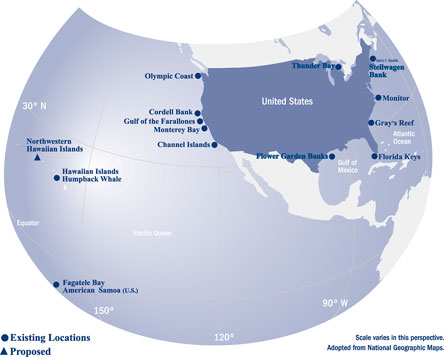








|

|

|

|

|

|

|

|
|
|
|
|
|
|
|
|
|
|
|
|
|
|
|
|
|
|
Click on the image for a larger map. |
Click on the image for a larger version of the map. 
In 1972, exactly one hundred years after the first national park was created, the nation made a similar commitment to preserving its marine treasures by establishing the National Marine Sanctuary Program. Since then, thirteen national marine sanctuaries, representing a wide variety of ocean environments, have been designated. Today, our marine sanctuaries encompass deep ocean gardens, nearshore coral reefs, whale migration corridors, deep sea canyons, and even underwater archeological sites. They range in size from one-quarter square mile in Fagatele Bay, American Samoa to over 5,300 square miles in Monterey Bay, California, one of the largest marine protected areas in the world. Together these sanctuaries protect nearly 18,000 square miles of ocean waters and habitats, an area nearly the size of Vermont and New Hampshire combined. While some activities are regulated or prohibited in sanctuaries to protect resources, multiple uses such as recreation, commercial fishing, and shipping, are encouraged. Research, educational, and outreach activities are other major components in each sanctuary's program of resource protection. |
| Revised May 27, 2004 by Sanctuaries Web Group National Ocean Service | National Oceanic and Atmospheric Administration | U.S. Department of Commerce | NOAA Library http://sanctuaries.noaa.gov/oms/oms.html |